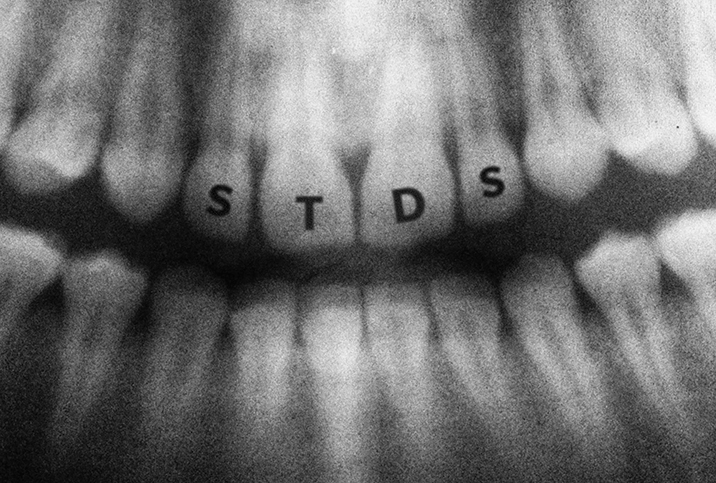An Oral STDs Checklist

Prevalence rates for several sexually transmitted diseases (STDs) have skyrocketed in recent years in the United States. According to the Centers for Disease Control and Prevention (CDC), three in particular have reached their highest point since tracking first began: chlamydia, gonorrhea and syphilis.
While the spread of STDs is often associated with vaginal or anal sex, these three STDs, as well as herpes, HPV and others, are likely seeing an uptick due to oral transmission. Before any sort of sexual encounter, evaluate the risks you're taking.
Chlamydia
In the U.S., chlamydia is the most commonly reported bacterial sexually transmitted infection (STI) across all age groups, with infections rising to a record 1.8 million cases in 2019. Chlamydia can be passed through oral transmission—either oral-to-genital or genital-to-oral contact—although vaginal and anal contact are more common sources.
Oral chlamydia could go unnoticed or exhibit the symptoms of a common sore throat. However, it can also cause mouth pain, dental issues, lip and mouth sores, and mouth sores that won't heal.
While oral chlamydia is relatively benign and treatable with antibiotics, it's important to remember that you can infect partners through oral transmission.
Gonorrhea
Another rising threat in the current STD landscape is gonorrhea. The U.S. sees an occurrence of around 1.14 million cases per year, according to the CDC.
Oral gonorrhea also can go completely unnoticed, but symptoms include a sore or burning throat, mouth sores, swollen glands and white spots in your mouth.
Gonorrhea is typically curable with a round of antibiotics. However, there is a more dangerous antibiotic-resistant strain that seems to be gaining a foothold, making it all the more important to practice safe sex and communicate with your partner about STD testing.
Syphilis
Syphilis is also making a grim comeback, with a recent 14 percent spike in U.S. cases and rising rates also seen in Europe. Especially troubling is that congenital syphilis—passed from a pregnant woman to her fetus—sharply increased from 2012 to 2014 across all U.S. regions.
Oral syphilis typically presents in these phases:
- Phase one: Small red patches on lips, tongue, gums or in the back of the throat, which develop into larger open sores. These usually disappear, but without treatment, the person remains infectious.
- Phase two: Skin rash, swollen lymph nodes and fever, which can last for years.
- Phase three: Issues with the brain, heart, nerves, eyes, blood vessels, joints, liver or bones.
The increase in syphilis rates is worrisome because it's a tricky disease to detect. While treatment with penicillin or other antibiotics is typically simple, it's important to be diagnosed early to prevent progression to the higher stages, which can result in irreversible, multisystem damage.
HSV-1 (herpes simplex virus type 1)
HSV-1 is generally passed by oral-to-oral or oral-to-genital contact, resulting in both oral and genital herpes. The World Health Organization (WHO) says about 3.7 billion people globally under age 50 are carriers. It's a lifelong condition even when you don't see symptoms, although outbreaks can be controlled with medication.
Oral HSV-1 presents with blisters or cold sores on your mouth, lips and throat.
Treatment for herpes can decrease outbreaks and the risk of passing the infection, but there is no cure.
HSV-2 (herpes simplex virus type 2)
HSV-2 is also transmissible via oral-to-oral or oral-to-genital contact, and affects nearly half a billion people globally between the ages of 15 and 49.
Oral HSV-2 may manifest as open sores in the mouth, difficulty or pain in swallowing, fever and chills, and, though rarely, may develop into herpes esophagitis. It can also sometimes affect the lower respiratory tract (larynx, trachea and bronchi).
As mentioned, there is no cure for herpes, but there are steps to reduce its effects.
HPV (human papillomavirus)
The CDC estimates nearly 80 million Americans have HPV, making it the most common STI in the nation. HPV can be spread through oral, vaginal or anal sex, and affects the throat, mouth, genitals, anus, cervix and rectum.
HPV may be present with no symptoms, but it can also develop into laryngeal or respiratory papillomatosis, with symptoms such as warts in the throat, difficulty speaking, vocal changes and shortness of breath.
There is no specific treatment for HPV, but vaccinations are recommended for everyone from age 9 to age 26. Adults between the ages of 27 and 45 may also receive the HPV vaccine, but they should consult their doctor about the risk versus reward.
What to do if you're exposed
If you suspect you've contracted an oral STI, seek testing immediately. Consequences for your health could be dire, but it's also vital to consider past and future partners. Straightforward treatments are available for most of these infections. And even for STDs that can't be cured, methods are available for keeping symptoms under control.


















